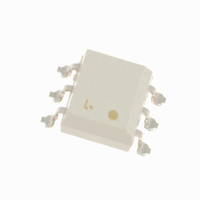TLP3063(LF1,S) Toshiba, TLP3063(LF1,S) Datasheet - Page 10

TLP3063(LF1,S)
Manufacturer Part Number
TLP3063(LF1,S)
Description
PHOTOCOUPLER TRIAC OUT 6-SMD
Manufacturer
Toshiba
Specifications of TLP3063(LF1,S)
Voltage - Isolation
5000Vrms
Number Of Channels
1
Voltage - Off State
600V
Output Type
AC, Triac, Zero Cross
Current - Gate Trigger (igt) (max)
5mA
Current - Hold (ih)
600µA
Current - Dc Forward (if)
20mA
Current - Output / Channel
100mA
Mounting Type
Surface Mount
Package / Case
6-SMD (300 mil, 5 Leads)
Lead Free Status / RoHS Status
Contains lead / RoHS non-compliant
Other names
TLP3063LF1S
36
4–6 Precautions for Assembly Using Mini Flat Coupler
1) Soldering
2) Cleaning
Avoid rise in the device temperature as much as possible by observing the following conditions.
a) Soldering lead directly (by solder header)
b) Reflow soldering
c) Precautions for heating
d) Dip soldering (Flow soldering)
2–1) The following types of solvents are recommended for cleaning the flux.
2–2) Cleaning Conditions
a) General precautions on dip cleaning
b) General precautions on ultrasonic cleaning
Recommended condidtions for standard ultrasonic cleaning
Cleaning must be conducted in a condition in which the printed circuit board or device should be floating on
the solvent used in order to avoid direct contact with the ultrasonic vibrator.
2–3) Handling Precautions
260˚C max, 10 second max, for once.
(1) Complete the reflow process for once within 30 second at a package surface temperature above 210 C.
(2) Atmospheric temperature close to mold body surface : 240˚C max, 10 second max
(3) Recommended temperature profile
(1) Soldering time has to be kept as short as possible.
(2) When using a halogen lamp or infrared heater, please do not irradiate the mold body surface directly.
Reflow soldering is recommended, because thermal stress is much less than in other soldering methodes.
Dipping time may differ depending on the solvent used.
However, as a general reference, it is recommended to limit the dip 3 minutes.
When ultrasonic cleaning is conducted for excessively long times, contact between product resin and
metal leads may lessen. Also, excessive ultrasonic stress may cause cracks in the pellet.
It is recommended to apply a minimum of stress.
Contact Toshiba when you plan to use dip soldering.
Toshiba Technocare (FRW-1, FRW-17, FRW-100)
Asahi Clean AK-225AES
Cleaning conditions and precautions may differ depending on the product specifications.
When cleaning the flux, reactive ions such as Cl and Na must be removed.
Frequency : 27 to 29kHz
Output : 0.25 W/ cm
During cleaning, or when cleaning liquid is being applied to a device, do not touch the device-marking
surface with hand or brush. Device markings may be erased.
It is necessary to confirm the safety of the solvent used for cleaning, as well as cleaning conditions,
so as not to harm the device package.
2
or less
Time : 30 seconds or less
Temperature : 50˚C (may differ depending on the solvent used)
( C)
240
210
150
60 to 90
Kao Cleanthru 750H
Pine-alpha ST-100S
30
times (s)













